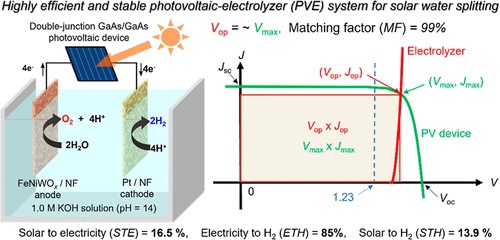
新潟大學:太陽能-氫氣轉換效率為13.9%!
-太陽能分解水的綠色制氫系統-
新潟大學
國家先進工業科學技術研究院
2022 年 7 月 1 日,
聯合研究組
採用“太陽能電池和高效水電解電池”,
開發“太陽能水分解綠色制氫系統”。
太陽能-氫氣轉換效率為13.9%。
它證明了“氫氣可以穩定生產一個月”。
太陽能水分解
綠色制氫系統
利用來自太陽光的電力通過水電解生產綠色氫氣。
陽光 – 氫轉換效率(STH)很重要。
太陽能-氫氣轉換效率(STH)的計算:
STH (%) 是
太陽能電池的太陽能電轉換效率 (STE)
× 水電解槽的電氫轉換效率(ETH)
× 太陽能電池與水電解電池的最大輸出比(MF)
計算公式為×100。
為了提高 STH,“需要對 STE、ETH 和 MF 進行優化”。
這項研究:
含有鐵、鎳和鎢的混合金屬氧化物 (FeNiWOx),
發現“它作為一種高活性和穩定的析氧催化劑發揮作用”。
研究組:
使用水電解電池和 2 結 GaAs 太陽能電池
太陽能水分解是在偽太陽光(1個太陽)照射下進行的。
太陽水分解結果
世界最高水平的STH
“STH 為 13.9%(STH 為 6.1 至 16%)1 個月”,
證明了“水可以穩定地制氫”。
根據新潟大學的公告,“它是世界上最高水平的STH”。
“ETH 分別為 85% 和 MF 分別為 99%”,這有助於 STH 的改善。
未來,我們將進一步改進水電解電池和太陽能電池,力爭達到25%以上的STH。
–fabcross 工程師
https://engineer.fabcross.jp/archeive/220706_niigata_u.html
Université de Niigata : L’efficacité de la conversion solaire-hydrogène est de 13,9 % !
-Système de production d’hydrogène vert par décomposition solaire de l’eau-
Université Niigata
Institut national des sciences et technologies industrielles avancées
1 juillet 2022,
Le groupe de recherche mixte
Utilisant “une cellule solaire et une cellule d’électrolyse de l’eau à haut rendement”,
Développement d’un “Système de production d’hydrogène vert par décomposition solaire de l’eau”.
Le rendement de conversion solaire-hydrogène est de 13,9 %.
Il a démontré que “l’hydrogène peut être produit de manière stable pendant un mois”.
Décomposition solaire de l’eau
Système de production d’hydrogène vert
Production d’hydrogène vert par électrolyse de l’eau à partir d’électricité issue de la lumière solaire.
L’efficacité de conversion lumière solaire-hydrogène (STH) est importante.
Calcul du rendement de conversion solaire-hydrogène (STH) :
STH (%) est
Efficacité de conversion solaire-électrique (STE) des cellules solaires
× Efficacité de conversion électricité-hydrogène (ETH) de la cellule d’électrolyse de l’eau
× Rapport de sortie maximal de la cellule solaire et de la cellule d’électrolyse de l’eau (MF)
Il est calculé par la formule de × 100.
Pour améliorer STH, “l’optimisation de STE, ETH et MF est nécessaire”.
Cette étude:
Un oxyde métallique mixte (FeNiWOx) contenant du fer, du nickel et du tungstène,
Il a été constaté qu ‘”il fonctionne comme un catalyseur de dégagement d’oxygène hautement actif et stable”.
Groupe de recherche:
Utilise une cellule d’électrolyse de l’eau et une cellule solaire GaAs à 2 jonctions
La décomposition solaire de l’eau a été réalisée sous irradiation pseudo-solaire (1 soleil).
Résultats de la décomposition solaire de l’eau
STH au plus haut niveau mondial
“STH est de 13,9 % (STH est de 6,1 à 16 %) pendant un mois”,
Il a prouvé que “l’hydrogène peut être produit de manière stable à partir de l’eau”.
Selon l’annonce de l’Université de Niigata, “c’est le plus haut niveau STH au monde”.
“ETH est de 85% et MF est de 99%, respectivement”, ce qui contribue à l’amélioration de STH.
À l’avenir, nous améliorerons encore la cellule d’électrolyse de l’eau et la cellule solaire, visant un STH supérieur à 25 %.
–fabcross pour ingénieur
Universität Niigata: Solar-Wasserstoff-Umwandlungswirkungsgrad beträgt 13,9 %!
-Grünes Wasserstofferzeugungssystem durch solare Wasserzersetzung-
Niigata-Universität
Nationales Institut für fortgeschrittene industrielle Wissenschaft und Technologie
1. Juli 2022,
Die gemeinsame Forschungsgruppe
Mit “Solarzelle und hocheffizienter Wasserelektrolysezelle”,
Entwicklung eines „Grünen Wasserstofferzeugungssystems durch solare Wasserzersetzung“.
Die Umwandlungseffizienz von Solar-Wasserstoff beträgt 13,9 %.
Es zeigte, dass “Wasserstoff einen Monat lang stabil produziert werden kann”.
Solare Wasserzersetzung
Produktionssystem für grünen Wasserstoff
Produktion von grünem Wasserstoff durch Wasserelektrolyse unter Verwendung von Strom aus Sonnenlicht.
Sonnenlicht-Wasserstoff-Umwandlungseffizienz (STH) ist wichtig.
Berechnung des Solar-Wasserstoff-Umwandlungswirkungsgrads (STH):
STH (%) ist
Solarelektrischer Umwandlungswirkungsgrad (STE) von Solarzellen
× Strom-Wasserstoff-Umwandlungseffizienz (ETH) der Wasserelektrolysezelle
× Maximales Leistungsverhältnis von Solarzelle und Wasserelektrolysezelle (MF)
Er wird nach der Formel × 100 berechnet.
Um STH zu verbessern, „ist eine Optimierung von STE, ETH und MF erforderlich“.
Diese Studie:
Ein Mischmetalloxid (FeNiWOx), das Eisen, Nickel und Wolfram enthält,
Es wurde festgestellt, dass “es als hochaktiver und stabiler Katalysator für die Sauerstoffentwicklung fungiert”.
Forschungsgruppe:
Verwendet eine Wasserelektrolysezelle und eine GaAs-Solarzelle mit 2 Übergängen
Die solare Wasserzersetzung wurde unter Bestrahlung mit Pseudo-Sonnenlicht (1 Sonne) durchgeführt.
Ergebnisse der solaren Wasserzersetzung
Weltweit höchste STH
„STH ist 13,9 % (STH ist 6,1 bis 16 %) für einen Monat“,
Es bewies, dass “Wasserstoff stabil aus Wasser hergestellt werden kann”.
Laut der Ankündigung der Niigata University “ist es das höchste STH-Niveau der Welt.”
„ETH beträgt 85 % und MF 99 %“, was zur Verbesserung von STH beiträgt.
In Zukunft werden wir die Wasserelektrolysezelle und die Solarzelle weiter verbessern, um eine STH von über 25 % anzustreben.
–fabcross für Ingenieur
Green Hydrogen Production through Solar Water Splitting: World’s Highest Level of Solar-to-Hydrogen Efficiency (13.9%) Achieved | News | NIIGATA UNIVERSITY
https://www.niigata-u.ac.jp/en/news/11753/
Perfect Matching Factor between a Customized Double-Junction GaAs Photovoltaic Device and an Electrolyzer for Efficient Solar Water Splitting
ACS Applied Energy Materials
Abstract
A photovoltaic (PV) device of double-junction GaAs/GaAs
was customized to match up with the current density–voltage property of an efficient electrolyzer with a FeNiWOx/nickel foam (NF) anode and a Pt/NF cathode.
The customization of the PV device resulted in
a perfect matching factor (MF = 99%) in performances between the PV device and the electrolyzer for solar water splitting in a PV-electrolyzer (PVE) system.
Efficient and stable (one-month) solar water splitting with a high solar-to-hydrogen efficiency (STH) of 13.9%
was demonstrated under 1 sun irradiation conditions.
The STH value
is comparable with the top values (14.2–16%) in the state-of-art PVE systems.The high STH
is based on an obvious progeny of the highest electricity-to-hydrogen efficiency (ETH = 85%)for the electrolyzers among the PVE systems with the non-precious metal-based anode in the electrolyzer and the perfect MF value (99%).
This demonstrates
that the perfect matching between the PV devices and the electrolyzers,as well as the development of the efficient electrolyzer successfully contribute to substantial improvement of STH and stability.